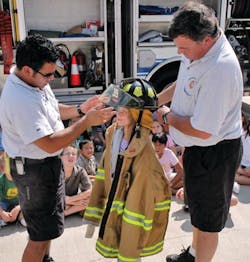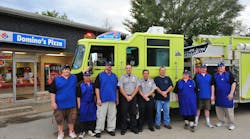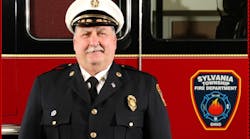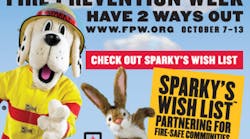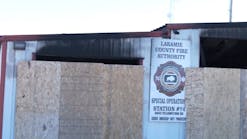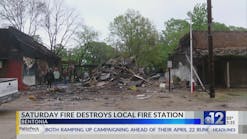Forty-nine years after the Great Chicago Fire, President Woodrow Wilson issued the first National Fire Prevention Day proclamation in 1920. Two years later Fire Prevention Day was expanded to Fire Prevention Week. Since then, Fire Prevention Week has been observed between the the Sunday through Saturday week in which October 9 falls, the day the Great Chicago Fire began.
For decades, firefighters have visited schools and have educated people of all ages about the dangers of fire. I remember as I am sure you do, being a child and feeling the excitement of visiting a fire station or of seeing firefighters on a big red fire engine arriving to our school. Although we repeat the fire safety message many times during the month of October we can never say it enough times. We say it so often we may assume that children have heard the message before, but for some children it may be the first time they have learned the importance of calling 911, or how to react if a fire does occur.
Picture yourself as a fireman in 1940, 1950 or 1960. Your uniform probably consisted of a long sleeve shirt and tie with a dress hat. Your engine was constructed of steel with a manual transmission, and most of the tools were mounted on the outside of the apparatus rather than stored in compartments. While our uniforms and equipment have certainly changed over the years, what have not changed are the basics of the fire prevention message. They include:
- Children should not play with matches or lighters. Remind children that they should find an adult, and not touch these items if they are found. Keep matches and lighters out of the reach of children.
- Be careful when using candles, and never leave them unattended - it is safer to use a flashlight should there be a power failure.
- Never leave the kitchen when using the stove or the microwave - kitchen fires are the number one cause of residential fires.
- Stay low in smoke and crawl to safety. You can practice while blindfolded or in the dark.
- Have a pre-designated meeting place outside the home.
- Practice fire drills. This should include all family members regardless of age.
- Have a smoke alarm and change the batteries twice a year. Most residential fire deaths occur in homes without operating smoke alarms.
- Have a fire extinguisher in your kitchen and know how to use it. Check it regularly to make sure it is charged.
- Children should learn their address and how to call 911. If there is a fire, the 911 call should be made from a safe location outside the home.
- Never take the time to remove pets or valuables. Remember most home fires can kill residents within three minutes from the start of the fire, and it takes on average 90 seconds for an operational smoke alarm to activate. That means after alarm activation you have only 90 seconds to get out. Often it is too late to get your children to safety; they need their own rehearsed escape plan.
I am astonished when I speak with community groups how many adults lack proper education in fire safety. Remember that fire prevention is not just for children.
This year’s message promoted by the National Fire Protection Association is “Have 2 Ways Out.” Now is the time to put your plan into action. The life you save may be someone you know.
BRIAN STOOTHOFF is an assistant chief with Ocala, FL, Fire Rescue. He is a 30-year member of the department and was the recipient of a Firehouse Magazine Heroism and Community Service Award. He can be reached at [email protected]
